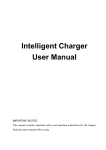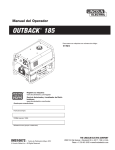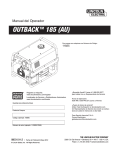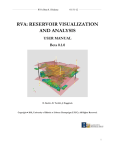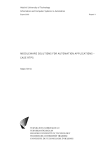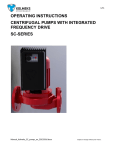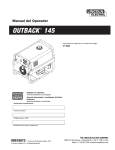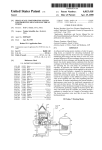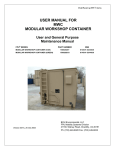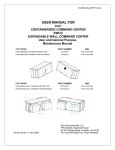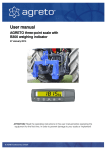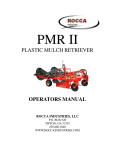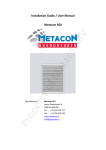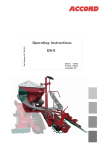Download Titan 3000 / 4000 - Tume
Transcript
NO: A‐98786604 15.2.2013 TUME-AGRI OY USER MANUAL Tume Titan 3000 / 4000 Starting from the serial number AC 50695 We reserve the rights to structural changes r/new manual/TITANMANUALFIN Read the instruction manual before you start using the machine! EC Declaration of conformity TUME-AGRI OY P.O. Box 77 14201 TURENKI declares that the seed and fertilizer drill Tume Titan fulfils the regulations in the Machine Directive 89/392/EEC and the related changes in 93/44/EEC and 93/68/EEC. The machine design complies with the following national standards and specifications: SFS-ISO5692 Eero Tommila Managing director Tume-Agri Oy 1 1. FOR THE USER OF THE MACHINE AND FOR THOSE RESPONSIBLE FOR THE MACHINE We wish you the best success with our TUME seed and fertilizer drill. This instruction manual gives you the correct methods to use, adjust, maintain and store Tume Titan. When you follow the instructions in this book your machine will serve you impeccably for a long time. It is very important to read the instructions well in advance of starting the seasonal use of the machine. Keep the user manual safe and easily available. There is a storage space for the user manual in a box at the right side of the machine. The space is marked with a sticker. Both the manufacturer, Tume-Agri Oy, and an authorised dealer are happy to help you with any machine-related issues. Please note the following about the presentation of this manual Because this publication is distributed in international sales networks, the machines in the pictures (as well as their standard equipment and accessories) may vary according to the country. In certain countries the statutory and otherwise important guards have in some pictures been opened or removed so that the item in the picture can be seen more clearly. It is not permitted to use the machine without guards. Ensure for your own safety that all guards are intact or installed in place before you start working. The "left" and "right" side mentioned in this manual are established from the vantage point of looking at the machine from the back towards the front. Tume-Agri Oy continuously develops its products and therefore reserves the right to change and improve them without committing itself to make changes to previously sold products. 2. GENERAL SAFETY INSTRUCTIONS All persons who use, maintain or otherwise handle the TUME seed and fertiliser drill must familiarise themselves with this user manual before they start working with the machine. It is absolutely forbidden to work or remain underneath a machine with unsupported hydraulics. Ensure that the machine stays elevated by closing the safety valves in the lifting cylinders. Lower the machine down if you have to leave it unsupervised. Do not leave the machine on a slope when you remove it from the tractor. It is forbidden to be on top of the machine or on the step when the machine is moving. The driver must make sure that no people are near the machine when it is moving. It is forbidden to lubricate, adjust or clean the machine when it is moving. Turn off the tractor engine and switch on the handbrake during maintenance work. All guards must be fixed in place. Ensure that the drawbar, hydraulic hoses and electric cables are connected correctly to the tractor and the machine. Any broken hydraulic hoses and connectors must be replaced immediately. The tractor's hydraulic valves and connections must not leak and they must be in good condition. The machine's transportation position depends on them. The hydraulic tramline markers available as accessories may move extremely fast, especially if their hydraulic choke valves are too open and the tractor produces too much hydraulics. Be especially careful when attempting to lift and lower the markers for the first time. Make sure that nobody is under the marker which is lifted up with hydraulics, or within the reach of the trajectory. 2 Make sure that the front axis of the tractor holds at least 20 percent of the tractor's weight under all circumstances. Use extra weights if necessary. Be especially careful if the seed and fertiliser drill is connected to the front tillage equipment and you lift it with the tractor's lifting device, during reversing, for example. The fastest allowed speed in good conditions is 30 km/h. On uneven surfaces you must take extra care and lower your speed. Transportation should be made when the hoppers are empty. It is forbidden to carry a load on top of the machine. Avoid driving over stones and other obstacles to save tyres. Never select a line of drive where the furthest wheels of the machine are "on top of nothing". This is when the machine may tilt too much. Selecting a wrong line of drive may lead to the machine falling over. Be very careful when moving on top of the machine during cleaning and maintenance or when filling the hopper. The painted surface of the machine may emit gases hazardous to health when it is heated. Ensure good ventilation of the working area during any welding work, for example. Use only the accessories and devices approved by the manufacturer. Any changes differing from the manufacturer's instructions and their consequences are the responsibility of the person making those changes. We recommend that a respirator mask is worn, especially when filling the seed dressing device, which is available as an accessory. The seed and fertiliser drill does not cause substantial increase in the noise level in the tractor's cab. The need to use any hearing protectors depends on the tractor's noise level. When handling heavy and sharp components (such as the parts of the drawbar and the coulters), we recommend using safety boots. Keep your machine up to date with regard to the required road traffic regulations if you must transport your machine on public roads. These regulations may often change. 3. PURPOSE OF USE General Tume Titan – seed and fertiliser drill is designed for simultaneous seeding and fertilising, especially in minimally tilled conditions. However, Titan is also well suited for seeding traditionally cultivated soil. When required, the machine can be used for seeding only or fertilising only with the preconditions mentioned later on. Titan's support wheel set is structured in such a way that it closes the seed furrow and also conveniently makes the soil compact. Accessories can be used to add to Tume Titan's features, and then the combination of the machine and the accessory can be used simultaneously with seeding and fertilising, during the same drive, to till or level the field, sow grass seeds, disinfect the seed to be sown as well as dig furrows for plant protection spraying. It is forbidden to use Tume Titan for other purposes than those mentioned. For example, the machine is not designed for transferring material at speed or for storing materials in the machine's hoppers. The machine should be filled close to the field to be sown and the transportation speed, when loaded, should be reasonably low with a sensible ratio regarding the load in the hoppers and the uneven surfaces of the ground. It is absolutely forbidden to carry people on the machine! 3 Using the machine exceptionally for sowing only If you are not using the fertiliser you should move the divider wall in the hopper to its furthest front position in order to maximise the seed hopper volume. With certain reservations it is also possible to sow grain crops through both hoppers. Thus the whole hopper capacity can be used to sow seeds. Take care also that the sieves on the fertiliser side do not puncture the seeds to be sown. If so, the sieves must be removed. When performing calibration test the total amount of sowing is obtained by adding together the calibration totals from the fertiliser side and seed side. We recommend that you sow about 70% from the sowing amount from the seed side and the remaining 30% from the fertiliser side. For example: If the total sowing amount is 300kg per hectare, sow 210kg per hectare from the seed side and 90kg per hectare from the fertiliser side. With the above mentioned special cases it should be remembered that the sowing charts supplied with the machine do not apply. Using the machine for fertilising only Tume Titan can also be used for applying fertiliser only, on at least minimally tilled fields. For this purpose the fertiliser is filled into either the fertiliser hopper or seed hopper or both. When the whole machine is filled with fertiliser, you must remember that fertiliser is usually heavier material than seeds. This is why the machine must not be filled to the full and the maximum total weight allowance given in the specifications must be followed. 4. GENERAL SOWING-RELATED INSTRUCTIONS Selecting the seeding depth With Tume Titan the fertiliser and seed is sown into the soil through the same coulters. There is no need to change the hopper's height from the ground, because there are no separate fertiliser coulters. The machine's upper and lower positions have been pre-set in the factory so they don't have to be changed. The upper and lower positions are limited with an electric valve. NOTE! If you have to use the machine without connecting the power cables, you must be careful not to lift the machine too high or lower it too low: - If the peripheral support for the wheels of the machine is reduced, the machine is too high. - If the machine rests on the lifting cylinder limiters it is too low down. Lift the machine about 2cm. The seeding depth is adjusted by pressurising the coulters. The main rule is that the seeding depth is determined by the tilling: The seed is sown into the bottom of the tilling, when the capillary increase of the dampness in the soil is at its best to benefit the seed and sprouting will be even. When selecting the seeding depth, the seed's requirements and the soil's dampness conditions must be taken into account. Find out about the seeding depth for the seed in a good time and try and arrange the sowing time so that the soil in the suitable depth is damp enough at the time of sowing. Usually the working depth for small seeds fluctuates between 1 and 3cm, and for normal grains the suitable seeding depth is 3-5cm. Correct sowing time Determining the correct sowing time is based on the dampness and temperature of the soil, as well as monitoring the current and forecast weather conditions. The type of soil and the crop to be sown have a fundamental effect on the optimal seeding time so universal guidelines cannot be given here. At the time of sowing the soil in the seeding depth should be tillable, but still damp. The soil is too damp for sowing, if you can make cohesive "long loaves" by hand from the soil material. The time of sowing for the plants which cannot withstand frost or cold may have to be postponed regardless of the soil's dampness, if the forecast or current temperature conditions so require. 4 Sowing into the minimally tilled soil Tume Titan is ideal for sowing into the minimally tilled soil. For minimal tilling you should use equipment which leaves an even, suitably fine and compacted soil and where its seeding depth can be adjusted with sufficient accuracy. Minimal tilling performed just before sowing should, at least on clay soil, be made a little deeper than the seeding depth. Thus it is ensured that the dampness in the seeding depth will remain. The recommended minimal tilling method for spring sowing is to perform the tilling in the autumn to the depth of 10-12cm, when the plant debris will mix into the topsoil and do not form an insulating layer on the surface. This method enables the start of normal time sowing in spring, which is important, at least in the countries with a short growing period. With Tume Titan you can sow in spring straight into the soil which was lightly tilled in the autumn, if the field is sufficiently flat. If required, the light surface tilling can be made during sowing by connecting the Tume CultiPack cultivator to the front of the seed and fertiliser drill. Please note that especially in spring the tilling must not be deeper than the seeding depth. Sowing into the normally tilled soil The sowing cultivation must be made into the shallow and, especially on clay soils, maximum seeding depth. This ensures that the dampness is better preserved which ensures better sprouting. It is easy to adjust the coulter pressure in Tume Titan, because it is done with hydraulics. This is done with a single-action hydraulic valve. Monitor the seeding depth of the seed. Ensure that on clay soil, for example, has enough pressure so that the seed will go to the bottom of the seeding depth. On the other hand, the coulter pressure should be less on the light soil, so that the seed does not go in too deep. Because the machine combination Tume Titan & tractor is rather heavy, we recommend that when you sow into tilled soil you use the middle packer (pictured below) to level the sprouting. Picture 1. Middle packer (accessory) 5 5. TYRE EQUIPMENT FOR THE MACHINES MOVING ON THE FIELD When moving in fields you should pay attention to preserving and improving the soil structure, so that the water management is functioning. The soil surface should also be as even as possible. The machine should move in the field with the tyre equipment which guarantees sufficiently low surface pressure and the weight of the axes should be as low as possible. You should also avoid moving around in the field in very wet conditions. 6. TAKING THE MACHINE INTO USE Operational principle for the set of wheels The support wheel set works so that the longer cylinders at the machine's ends turn a tubular frame, which is as wide as the machine, and the furthest pairs of wheels are also attached to this frame. The middle wheel pairs are attached to the tubular frame with hinges and they work with their own cylinders. All these cylinders are connected to the same hydraulics circuit so they all have the same pressure. This is why the pairs of wheels can adjust to the uneven ground surface, but the rolling power is still constant for the whole working width (picture 2). The geometry of the support wheel set is designed in such a way that in the working position (the machine is lowered) the pressure under all wheel pairs is about the same. When the machine is lifted to upper position the unconnected wheel pairs in the centre carry a little more load. Thus the probability of damaging the furthest wheel pairs is reduced. These damages often happen during transportation. When Tume Titan is lifted onto a lorry (loading the machine in the factory, for example), a lifting device specially built for this operation is used. The lifting is performed from the centre wall, in the driving direction, which is inside the machine's hoppers. It has 2 oblong holes, through which the lifting devices are threaded (you need 2) and to which the lifting chains are attached. Ensure that the lifting chains are of even lengths: Titan must be in a straight position for the whole lift. Open the tarpaulin cover totally for the lift's duration to avoid damaging it! Titan can also be loaded onto a lorry using a loading ramp, or a transport carriage with a sufficiently gradual ramp where the driving ramp is as wide as the machine's rear wheel set. The middle wheel pairs must not fall in between the loading ramps. For the furthest wheel pairs it is enough that one of the wheels is on the pallet if the machine is transported in the driving direction. Note also the scrapers of the rear wheel set when reversing; they are close to the ground. Look out for obstacles! When reversing over a high threshold or similar, the scrapers lift up higher if the machine is lowered a bit. Check that you have enough room under the coulters so that they don't hit obstacles. Picture 2. Support wheel set 6 Installing the drawbar The drawbar is assembled as shown in picture 3, which also shows how the drawbar is attached to the machine. Note that the drawbar is always attached to the uppermost holes of the machine's lower brackets. The lower holes are for attaching a spring front field drag, for example. The push bar is also attached to its uppermost hole. Hydraulic hoses and electric cables are attached to the drawbar carefully in such a way that they cannot be damaged under any driving situations (such as when diving into the tractor's handle). Thread the hoses through the inside of the box girder. Picture 3. Drawbar Adjust the length of the push bar so that the machine is horizontal when lowered and attached to the tractor's towing hook. The fine-tuning of the drawbar is made in the field when sowing. Attaching the machine to the tractor Tume Titan is attached to the tractor's towing hook as normal. We do not recommend attaching the machine to the tractor's tow bars, because it makes the front end of the tractor lighter and makes controls less effective. Instead the machine can (and is recommended to) be attached to the middle packer (Picture 1). When the seed and fertiliser drill is attached to the back of the tractor, lift the support base up. Place the tractor's tow-bars at such a height that they don't touch the drawbar or the hydraulic hose controls. Titan's hydraulics are connected to the hydraulics output meant for the tractor's externals single-action cylinders. If the machine's accessories include markers, they work with the same hydraulic valve as lifting and lowering the machine, but in that case the machine must be connected to the tractor's dual-purpose hydraulics. It must be noted that with many tractor types you must use the quick couplings recommended by the tractor manufacturer or similar. Replace these parts if needed with the types suitable for your tractor in order to ensure that the hydraulics function impeccably. If Titan is attached to the CultiPack cultivator, available as an accessory, it must be equipped with a different type of a drawbar, which is called multifunctional drawbar. The drawbar can be shifted into two positions: Bent or straight on the top. The bent position is used for the CultiPack. The straight lower position is used when towing directly from the tractor's hook or when using the middle packer. The hoses and electric cables are connected to the multifunctional drawbar by threading them through the base part and leading the tow link via the steel links on the part onto the tractor. 7 Driving instructions When you lower the machine down always move it forward at the same time. Otherwise the coulters may clog up. Avoid driving unnecessarily on the sown area. Choose a driving technique which leaves as few wheel tracks on the sown area as possible. In its upper position the machine is supported by the tractor's hydraulic valve. This is why you must ensure during transportation that the tractor's hydraulic valve cannot accidentally open or leak. The safety taps of the end lifting cylinders must always be kept open during road transportation! (Picture 4 below) On even ground the machine must function in horizontal position. If the machine moves whilst tilted forward, the push bar of the drawbar must be lengthened. If the machine moves whilst tilted backwards, the push bar must be shortened. Check and adjust the seeding depths after driving a short distance, if needed. Check the adjustments for the markings by also inspecting the sowing seam. NOTE! Lift and lower the machine only when it is moving forward. Never reverse the machine when coulters are on the ground and the power transmission is switched on. Check from time to that the coulters are not blocked. Check also the condition of all seeding tubes and fertiliser tubes and clean out any blockages. At the start of the sowing check out the area that can be seeded with one hopper-full. After this the correct filling time can be determined from the Agrocont computer controller's area counter. Keep enough seeds and fertiliser in the hopper. Because of the design of the bottom you must pay special attention to this, especially at the start. Don't leave fertiliser or seeds in hoppers for several days, especially in damp weather. Damp fertiliser can cause feed problems. Tume Titan is always equipped with double-disc coulters. At high seeding speeds the vertical fluctuation of seeding is more common with disc coulters than with a machine with Suffolk coulters. Monitor the seeding depth and change the seeding speed as required. The suitable speed for tilled soil is usually about 7-10km/h. When sowing peas, the maximum speed is 6-7km/h. Transportation speed is 30km/h. Picture 4. Safety tap 8 7. GROUND WHEEL FOR THE FEEDING SYSTEM The feeding system gets its power from a ground wheel on the left side of the machine. The ground wheel is attached to the hopper and thus it rises up when the machine is lifted. When the machine is lifted, the ground wheel leaves the ground and the feeding stops. Thus you don't need a separate power transmission switch in the machine. NOTE! Do not rotate the ground wheel into reverse direction! Always lift the machine up before you reverse the tractor. The moment of releasing and switching can be controlled by adjusting the ground wheel either higher or lower in relation to the hopper. This takes place by adjusting the attachment point of the cable in the centre of the tubular frame of the wheel set. It is also possible to push the ground wheel in for transportation. Thus the machines maximum overall transportation width will be the nominal width: 3 or 4 metres. The alternative positions are shown in pictures 6 and 7. Lock the ground wheel into the sowing position with your fingers turning the screw in the base of the supporting rod sleeve and lock it using the locking nut (19mm key). Picture 6: Ground wheel in working position Picture 7: Ground wheel in transport position 8. FILLING THE HOPPERS Timing the filling Before starting sowing we recommend that the machine is transported to the field whilst empty. The fertiliser and seeds are brought to the field on a trailer, for example, and the seed fertiliser is filled at the edge of the field. If you have to fill the machine far from the plot to be seeded, you must be very careful when transporting the machine with full hoppers. The maximum speed of 30km/h is only allowed on good roads with empty hoppers! The maximum allowed speed with full hoppers is 15km/h. Keep the rubber rings of the tarpaulin fastened especially during transportation! Emptying the containers may be monitored: By looking into the hopper from time to time with the machine stopped. By monitoring the machine's area counter once it has been determined how large the area to be seeded with one hopper-full is, and the meter reading from the previous time is memorised. With the electronic controller (Agrocont), which is included as standard. The device sounds an alarm when there is only a certain amount of fertiliser or seed left in the hopper. 9 Adjustable hopper volume The divider wall between the fertiliser and seed compartments is adjustable so that the volume ratios can be adjusted. The adjustment is made by opening the locking screws in the dividing wall support rods and turning the dividing wall into the required position (Picture 8). Remember to lock the support rods after adjusting. Note that the height of the dividing wall is also adjustable. Picture 8. The adjusting rod of the hopper's dividing wall Filling method The machine's filling height is quite high and it has large hopper volume. This is why we recommend using large sacks for both the seeds and the fertiliser (NOTE: use adequate lifting equipment or maybe loading screw technology). Large sacks can be handled with different loaders. Do not go under a hanging load. The large sack must not be lowered on top of the seed and fertiliser structures. Do not overload the seed and fertiliser. Find out about these methods in order to partially empty the large sack. 9. EMPTYING THE HOPPERS Emptying the fertiliser hopper The fertiliser hopper is usually emptied through the coulters. Adjust the feed controls to the maximum position, spread the tarpaulin under the machine and push the lever of the bottom valves on the fertiliser side all the way down. Then almost all of the hopper will empty. Push the remaining fertiliser, with a broom for example, into the feed chambers. Turn the feeding system round with a crank a few times so that the chambers will empty. Finally swing the bottom valves quickly with the crank a few times to remove the fertiliser from the top of the shutters. NOTE! Detach the seed-side transmission cassette before turning the ground wheel. Then seeds will not mix with fertiliser and the varieties don't get mixed up. Emptying the seed hopper The seed hopper is emptied in the same way as the fertiliser hopper. NOTE! If there is fertiliser in the fertiliser hopper when seed hopper is emptied, remove the pin from the feeder axle (in the left side of the machine). NOTE! Do not empty both hoppers at the same time so that the fertiliser and the seed don't mix together. 10 10. SEED FEEDING SYSTEM AND ITS ADJUSTMENTS General description The seeding system consists of threaded rollers, bottom valves with springs and adjustable closing gates (Picture 10). The feed chambers are located on the bottom of the hopper. This solution has enabled the amount of seeding to remain almost the same regardless of the seed and fertiliser drill tilting to the side or to the driving direction. The feeding system is made from non-corrosive materials. The bottom valves below the feeding rollers are adjustable and the adjusting lever is at the rear in the middle of the machine (Picture 10). For sowing fine seed the gear ratio of the transmission can be changed by rotating the transmission cassette. Picture 9. Adjusting the feed with the hand wheel Picture 10. Principle of the feeding system The amount of feed is adjusted by turning the feed roller sideways in relation to the feed chamber. The adjusting is made with the hand wheel at the left end of the machine. The hand wheel is locked with a plastic lever which also has the main scale 0-10 for the feed, where the gap between numbers is the same as one turn of the hand wheel. The adjustment is read from the inner surface of the hand wheel. The hand wheel has 10 locking positions for each turn and they are marked 0-9. Thus you can have a total of 100 different adjustment positions. With the fine seed transmission (cassette position II) you can similarly have 100 feeding positions from a smaller area. NOTE! In order to adjust the feed the plastic lever must be pressed to the end of the machine to the direction of the arrow and turned 90 degrees at the same time to release the locking. When the hand wheel is turned anti-clockwise the feed increases. When the required amount of seed is known, the sowing chart inside the machine's cover provides advisory adjusting position for the feeding. Note the position of the cassette in use. It is advisable to make the adjustment so that the required adjustment position is always approached from a bigger adjustment position. If the original adjustment position is smaller than the required one, the hand wheel must be turned anti-clockwise 1/2-1 turns past the intended adjustment, after which the wheel is turned back to the required position. 11 After the adjustment the locking lever is turned into the hole in the hand wheel to lock both the wheel and the lever. Please note that the adjustment position provided by the sowing chart is advisory and the actual amount of feed varies between different seed batches. We recommend that the amount of feed is checked with calibration. If dirt accumulates in the feeding system, the feed rollers may clog up. This can have a crucial effect on the amount of feed. We recommend a good clean from time to time. The rollers can be cleaned by setting the amount of feed to zero and then back to the required adjustment value. Then you must remember the previous instruction to turn the wheel first 1/2-1 turns past the required adjustment value. If the machine has a seed dressing device, the calibration must be run again after about one hectare's seeding. A mordant can reduce the amount of feed as much as 20%! NOTE! The hand wheel must not be turned to zero position by force. Simultaneous turning of the feeding axle makes adjusting easier. The use of the sowing chart and calibration test instructions are dealt with later. NOTE! The maximum speed when sowing peas and beans is 6-7km/h. Turning the transmission cassette Picture 11. Transmission cassette: Grain / Fine seed When the bigger chain wheel of the cassette is forward, it is set for grain. When the smaller chain wheel is forward it is set for fine seeds. The setting is marked in the cover of the cassette on its visible side. Picture 11 shows the setting for grain. Make the turn as follows: Remove the linchpins and pull the cassette off its axis. Turn the cassette upside down. The sticker on the cassette shows the setting. 12 Bottom valves The feeding accuracy depends on the distance between the bottom valve and the feed roller, so it is important that the bottom valves are in the correct position, and they are not adjusted after calibration without repeating the calibration. The bottom valves give way, if a hard foreign object gets between the drum valve and the feed roller. Here are the advisory adjustments to the most common seeds. If you sow other varieties than those mentioned, compare the seeds for their sizes and properties with those mentioned and run calibration according to these adjustments. Adjustment positions for the bottom valves: Grain seed notch 2 Peas notch 3 Fine seeds notch 1 Bean notch 4 Picture 12. Adjusting the bottom valves 11. FERTILISER FEEDING SYSTEM AND ITS ADJUSTMENTS General description The machine has as many fertiliser feeding chambers as those that feed seed. The amount of feed is adjusted by turning the feed roller sideways in relation to the feed chamber. The adjusting is made with the hand wheel at the left side of the machine. The feed chambers are located on the bottom of the hopper. This solution has enabled the amount of seeding to remain almost the same regardless of the seed and fertiliser drill tilting to the side or to the driving direction. The feed rollers are plastic rollers equipped with threaded cogging. The bottom valves below the feed rollers are adjustable. The adjusting lever is at the front of the machine in the middle. The whole fertiliser feeding system is made from non-corrosive materials. You can sow all grainy fertilisers through the fertiliser hopper. The feeding system is not suitable for feeding powdery fertilisers. 13 Adjusting the amount of fertiliser feed The amount of feed is adjusted from the hand wheel at the right end of the machine. The hand wheel is locked with a plastic part which also has the main scale for the feed. NOTE! In order to adjust the feed the plastic lever must be pressed to the end of the machine to the direction of the arrow and turned 90 degrees at the same time to release the hand wheel locking. When the hand wheel is turned anticlockwise the feed increases. When the required amount of seed is known, the sowing chart inside the machine's cover provides advisory adjusting position for the feeding. It is advisable to make the adjustment so that the required adjustment position is always approached from a bigger adjustment position. If the original adjustment position is smaller than the required one, the hand wheel must be turned anti-clockwise 1/2-1 turns past the intended adjustment, after which the wheel is turned back to the required position. After the adjustment the locking lever is turned into the hole in the hand wheel to lock both the wheel and the lever. Please note that the adjustment position provided by the sowing chart is advisory and the actual amount of feed varies between different fertiliser batches. We recommend that the amount of feed is checked with calibration. The machine can also be equipped with an accessory Agrocont-Plus, an electric fertiliser controller. In this case the fertiliser side does not have hand wheel and the adjustment is made with the lever mechanism which is operated by a spindle motor. The instructions on how to adjust the fertiliser is found in the Agrocont computer controller user manual. The normal position of bottom valves with grainy fertiliser is notch 2. If wet fertiliser enters the feeding system, feed rollers might clog up. This might have a crucial effect on the feed rate. The rollers can be cleaned by setting the amount of feed to zero and then back to the required adjustment value. Then you must remember the previous instruction to turn the wheel first 1/2-1 turns past the required adjustment value and then back to the correct value (from bigger to smaller). The instructions on how to use the sowing chart and how to perform calibration are explained later. The fertiliser feeder can be switched off by removing the linchpin from the end of fertiliser feeder axle from the left side of the machine. 12. EXAMPLES OF HOW TO USE THE SOWING CHART General Three examples of how to use the sowing chart below are drawn on the chart. Please note that the amount of seeding shown in the sowing chart is only advisory. The actual sowing amount depends on the properties of the seed used. These vary considerably yearly and by their varieties. The sowing amount must be checked by calibration and its operation is explained later. 14 Picture 13. Sowing chart 15 Example of adjustment when sowing grain Case 1: We want to sow oats, 200kg/ha. Note the correct position of the bottom valves from the top right of the chart, marked "cereal". The correct adjustment is "2". Select description "oats" Check the machine's transmission which should be "1" Let's start from the edge of the chart, from 200 kg/ha Proceed to the horizontal line where this line goes across the description "oats" From the crossing point we go straight down to the scale where we see that the adjustment must be "6.8" This means that the hand wheel must be opened for 6 turns plus another 0.8 turns on top. So the hand wheel is locked to the notch with the reading 8. Example of adjustment using fine seeds Case 2: We want to sow rape, 8 kg/ha. Note that on the top right corner of the chart the correct position for bottom valves is "1" Examine the small sowing chart We find the starting point from the left side of the small sowing chart at 8kg/ha Proceed along the horizontal line 8kg/ha to the right where this line goes across the description "rape" From the crossing point we go straight down to the scale where we see that the correct adjustment is "2.2" We note that on the top left corner of the small sowing chart is a mark "transmission II". So we must use the fine seed setting in transmission, so the cassette must be turned so that the cassette is on the level shown at position "II" Example of adjustment, fertiliser Case 3: We want to sow NPK mixed fertiliser, 500 kg/ha. We note from the top right corner of the sowing chart that the correct adjustment for the bottom valves is "2". We start from the edge of the big sowing chart, at "500 kg/ha" We proceed horizontally along the 500kg/ha line to the right to the point where this line and the description "granular fertiliser" cross From the crossing point we go straight down to the scale where we see that the reading in the main scale in the hand wheel lever should be "5.0". After the adjustments you should perform calibration in order to ensure correct sowing amount. 16 13. CALIBRATION General Because the adjustment values provided in the sowing chart are only advisory, you must perform calibration before seeding. Before starting calibration, adjust the machine according to the sowing chart. Check: Transmission cassette settings I / II Position of bottom valves (seed and fertiliser) The amount of seed feed from the hand wheel That the tram lining device is not in use The amount of fertiliser feed from the hand wheel That the closing gates are fully open That there is fertiliser and seed in the hoppers The machine is lifted a little from the ground so that the ground wheel leaves the ground and it can be turned. Turning is easy when the rotating tool is in its place as shown in picture 14. This rotating tool is located under the cover which is at the left side of the machine. It is easy to put the machine's tubing system (for seeds and fertiliser) to the calibration position all at the same time. This is done from the handle at the right side of the machine (Picture 15). Lift the clamping device upwards Pull the handle out with a firm grip, using both hands, up to its limiter Calibration can be made in three ways: At the same time for the seed and the fertiliser, when all pins of the transmission are in place. Separately for the seed, when the linchpin is removed from the end of the fertiliser axle. Remember to put the linchpin back after the calibration! Separately for the fertiliser, when the pin of the seed-side cassette is removed. Remember to put the linchpin back after the calibration! Picture 14. Ground wheel in a calibration position 17 Picture 15. Hose shelves in a calibration position Calibration tubs for both seed-side and fertiliser-side are supplied as standard with Tume Titan. You can also keep these tubs in place during sowing. However, always remember to empty the tubs from dust etc. before performing the calibration. After the calibration pull the calibration tubs out and weigh the seeds and fertiliser in them. NOTE! After you finish the calibration, remember to push the handle of the calibration equipment back inside (from the right side of the machine) and lock it with its spring. After this the seeds and fertiliser go back into the coulters instead of the calibration tubs. Finally close the protective cover at the right side. Picture 16. Emptying the calibration tub 18 Simultaneous calibration for seeds and fertiliser Turn the crank a few times so that the feeding chambers fill up properly. After this carefully empty the calibration tubs. Turn the ground wheel for the number of turns mentioned in the sowing chart for this machine type. The rotating speed must match the driving speed used. Weigh the seed and fertiliser in the sowing tubs. If the calibration was made with the number of turns per acre, the sowing amount per hectare is obtained by multiplying the weighing results by one hundred. After you finish the calibration remember to push the hose shelves back to the sowing position and lock the handle. Put the ground wheel rotating tool back to place and close the protective covers. Using the calibration equipment on the fertiliser side The test is performed as above, but the pin of the seed-side transmission cassette is removed for the duration of calibration. Instructions for improving sowing accuracy The calibration value in the sowing chart is advisory. The type of soil and tilling depth, for example, has an effect on its accuracy. This is why the sowing chart gives an advisory range for calibration values: Titan 3000: 11 – 12 r/a Titan 4000: 8.25 – 9 r/a The accuracy of the sowing amount can be increased by performing a towing test in sowing conditions. The towing test is performed by towing the machine for a distance needed to sow one acre and by counting at the same time the rotations of the ground wheel. Write down the resulting calibration value and use it when you perform calibrations. If the value you measured is vastly different from the value in the sowing chart, perform another test. The table below shows the distances "L" used in the towing test for different working widths. L = 33.3m, when the working width is 3.0m L = 25m, when the working width is 4.0m Check the accuracy of the area counter at the same time. 19 14. FIELD TEST Field test is absolutely the most reliable testing method for the sowing amount. If you perform the field test in the field to be sown and on the soil already tilled, you will achieve sowing conditions which match the sowing event very closely. Field test can be performed for both seeds and fertilisers. Performing the field test: Adjust the machine in accordance with the calibration instructions Measure the distance matching one acre of sowing, which for the machine models: Titan 3000 Titan 4000 33.3 m 25.0 m Drive outside the test distance for about 10 metres with the machine in working position so that each seed chamber feeds seed. Empty the contents of the calibration tubs. Drive a distance as shown in the above table at normal sowing speed with the machine lowered to the sowing position. Weigh the seeds and/or fertilisers in the calibration tubs and multiply the results by 100 so that you will receive the amount of seeds and/or fertiliser kg/ha. If checking is needed, do as described in the calibration instructions 15. ADJUSTING THE SEEDING DEPTH AND FERTILISING DEPTH NOTE! First of all remember to check that the machine is horizontal in the sowing position. The adjustment is made using the push rod on the machine's drawbar. Check the straightness from the seam between the hopper and the additional hopper: It must be in the same direction as the field surface. Lower the machine down whilst driving it forward at the same time. Stop the tractor whilst the machine is lowered. Don't allow the tractor to jerk backwards so that the coulters don't get clogged up. Check that the machine is in correct position. The machine must be in horizontal position. If required, adjust the machine so that it is horizontal from the push rod's adjusting screw. Correct seeding depth and getting the seed into the bottom of the tilled soil is one of the most important factors affecting sprouting. Tume Titan has large diameter double-disc coulters which penetrate well and which have notched outside perimeter. The coulters are designed to be used in both minimally tilled and traditionally tilled conditions. The Titan coulters can be pressurised with the power of as much as 60kg. The pressurisation takes place with the hydraulic cylinder using the tractor's single-action hydraulic valve. The coulter pressurisation is sufficient when the seed is placed correctly to the bottom of the furrow and maybe slightly below (= the coulter disc makes a small groove to the bottom). NOTE! Take care that pressurisation is not too strong, because for example with rape the seeding depth which is too deep can harm sprouting. We could say that the main rule with the sowing tilling depth is that the tilling must always be made into the intended sowing depth. The seeding depth must be selected in accordance with the crop and the dampness of the soil. The correct seeding depth for fine seed is 1 – 3cm and with grains 3 – 5cm. It is essential for all crops that the seeding is made into damp soil in order to ensure the germination. The seed must not be left in the dry loose soil. The driving speed must also be taken into account. If the driving speed is too high, it will increase the vertical spread of the seed in the soil. In certain circumstances you cannot use too high pressure on the coulters and especially then the coulters might bounce more if the speed is too high. Rule of thumb could be that every time you drive at higher speed than 12km/h, risks are increased. 20 Performing the adjustment The seeding depth is adjusted by changing the spring loading of the coulter extension spring. The basic adjustment to the pressurisation springs is made coulter-specifically with the chains on the extension spring. During the sowing the adjustment is made centrally with hydraulic cylinders. Titan has a mechanism in the coulter pressurisation which prevents the unnecessary loading of the coulters when the machine is in the upper position (picture 20, point D). When the machine is lifted the adjusting cylinder of the coulter pressurisation is able to move backwards with lever mechanism and the coulter pressurisation eases every time the machine is lifted. NOTE! The adjustment of the coulter-specific pressurisation from the extension spring chains (picture 20, point C) must be made when the machine is in the upper position with the springs released. Check in the sowing position that you get the sufficient coulter pressurisation with the cylinder. Avoid too much pressurisation strength! The pressurisation of coulters against the ground can be adjusted within the range 10-60 kp. The corresponding working depth depends on tilling and the type of soil. Monitor the working depth from time to time when the work is proceeding. The springs of the Tume Titan coulters are designed so that the coulter's height does not really effect the coulter's pressurisation. D C Picture 20. Central adjustment of coulters B A 21 16. ADJUSTING THE REAR HARROW Picture 19. Rear harrow The lateral distribution of the spikes in the rear harrow has been made in the factory. However, you should check the adjustment when the machine is sowing in the field and moves the spikes sideways. The lateral movement is adjusted so that the spikes move in the centre of the embankment between support wheels and the wheel track. The working angle can also be adjusted. The working angle is adjusted with taps which limit the square pipe (to which the spikes are attached) turning backwards. Vertical adjustment is made with edge chains. This adjustment affects not only the working depth, but also the moment of lifting: at which stage of lifting does the rear harrow leave the ground? The lower ends of the chains are equipped with protective tubes which also prevent the rear harrow being installed too high. If the rear harrow is adjusted too high, the rear step will be damaged when the machine is lifted up. Check the working depth every time when you change the rear harrow angle adjustment NOTE! After adjustments ensure that when the machine is lifted all the way up the rear harrow also raises enough for reversing and transportation. Remember that if the low lift is switched on, the rear harrow is on the ground and you must not reverse! The purpose of low lift is that when the machine is lifted up in the headland, the rear harrow stays on the ground and covers the tracks of the seed drill. See how to use low lift in the Agrocont user manual. 22 17. SEED AND FERTILISER DRILL MAINTENANCE We advise that you contact the dealer when you require more demanding repairs. The following presents actions which most of the time can be taken on a farm. Read the maintenance instructions carefully. If you follow the instructions, TUME- seed and fertiliser drill works impeccably from one year to the next. If you neglect the maintenance according to these instructions, the warranty will become void. Always switch off the tractor engine before starting maintenance work and switch the handbrake on. DANGER! ALWAYS CLOSE THE SAFETY VALVES IN BOTH LIFTING CYLINDERS, IF THE MACHINE HAS TO BE UP DURING MAINTENANCE. DO NOT GO UNDER THE MACHINE IF IT RELIES ONLY ON HYDRAULICS! Picture 20. Lifting cylinder safety valve open NOTE! Transportation is not allowed when safety valves are closed. The machine's hydraulic circuit is pressurised even when it has been removed from the tractor. DANGER! THE MACHINE'S PAINTED SURFACE MAY EMIT GASES HARMFUL TO HEALTH WHEN IT GETS HOT. TAKE CARE THAT THE WORKING SPACE IS SUFFICIENTLY VENTILATED, DURING WELDING FOR EXAMPLE. Lubricating the seed and fertiliser drill The transmission block chains must be lubricated at 50 hours intervals or when required. For lubrication, use only SAE 10 or SAE 20 lubricant. The adjusting screw of the drawbar's hydraulic push rod must be lubricated with lubricant and Vaseline annually. The ball bearings of the coulter discs are permanently lubricated so they don't require maintenance. The nipples which must be lubricated with a lubrication squeezer at 100 hour intervals are in the following locations: Wheel set: -the sliding surfaces of the strut in relation to the hopper -cylinder nipples Ground wheel: -hopper sleeve Transmission: -the user wheel of the fertiliser axle Central adjustment: -the tap of the rocker arm which moves the cylinder The central markers, available as accessories, also have lubrication nipples Check the tightness of the screwed joints regularly every 100 hours. The above mentioned checks must be made to a new machine twice after 25 hours and after this every 100 hours. 23 Noteworthy hints for using the machine Some large and light seeds (such as some types of oats) might have difficulties when the seeds flow through the sieves. In this case remove the sieves from the hopper. Take special care when filling the hopper so that no large particles can mix with the seed and damage the feeding system. Always lift the rear steps up when you drive the machine: Both in sowing work and transportation. Note that when we talk about the machine's protrusion, we mean two things: The protrusion which determines the accuracy of the sowing amounts means the protrusion of the ground wheel which rotates the machine's feeding system: How many times the ground wheel turns per acre (see 13, Instructions for improving sowing accuracy). The protrusion which affects the accuracy of the area measuring is determined with the support wheels protrusion. Find out, using a towing test, how far forward the machine moves in your sowing conditions, after the support wheel rotates once. The machine's calibrations are made into tubs under the feed chambers both on the seed-side and fertiliserside. Be very careful when pushing the tubs into place. Keep them in as straight a line as possible in relation to the machine. If the tub is pushed with force so that its end points upwards, the tub might hit some of the feed chambers and damage them. Your seed and fertiliser drill is equipped with an electronic control device which has surface sensors for the seed and the fertiliser so be careful when lifting the sieves from the hoppers. If a sieve hits a sensor it may damage it. You must also be careful when installing and removing the containers for the seed dressing device. If the protective cover on the right side of the machine does not close, you might have left the calibration settings on. If the calibration handler is pulled out, the cover cannot be closed. This is a good rule of thumb. Storage When the machine is not in use, it must be stored cleaned and serviced in a covered space. Lower the machine. Do not leave the machine on hydraulics. The hoppers are emptied from fertiliser and seeds. The machine is washed outside and inside with water. Use a pressure washer with care (Max. water temperature should be 60 degrees and pressure 100 bar), do not direct the spray into the ball bearings or the components of the electronic accessories, such as sensors and solenoids. Do not remove or damage warning, name or instruction stickers by washing them too hard. Lubricate the machine as instructed. The spots where the paint has worn off can be protected with anticorrosive oil. Any damages found during cleaning are recorded. It is advisable to order spare parts in good time before the start of the season, so that the repairs are completed on time. 24 18. TECHNICAL DETAILS Type Titan 3000 Titan 4000 Working width (m) 3.0 4.0 Hopper capacity (l) - Total (= available in organic) - Seed, min - Seed, max - Fertiliser, max 4070 1720 2900 2350 5640 2380 4010 3260 3050 6900 3850 9100 Basic machine dimensions (cm) - Height to the edge of the hopper - Width - Length without the drawbar 208 300 307 208 400 307 Support wheels - Size - Quantity - Pressure (bar) 7.50 – 16 12 1.5 – 2.0 7.50 – 16 16 1.5 – 2.0 Coulter pressurising - Coulter pressure / coulter (N) - Runtime weight adjustment 100 – 500 Hydr. Standard 100 – 500 Hydr. Standard Quantity of coulters (each) seed 24 32 150 2 each single-action 1 each single-action 1 each dual-action 170 2 each single-action 1 each single-action 1 each dual-action Basic machine weight (kg) - Empty - With full hoppers Wheat and fertiliser Hydraulics - Pressure (bar) - Connection with standard equipment Equipped with tramline markers 25 19. ACCESSORIES TUME continually develops its machines and accessories. If you wish to order new equipment for older machines, it is advisable to ensure the compatibility of the devices by contacting the manufacturer's representatives. Only the following TUME accessories can be used with TUME seed and fertiliser drills. Factory instructions must absolutely be followed when installing the accessories. Faulty installation or use of other than original TUME accessories may endanger the user's safety or damage the machine. The manufacturer is not responsible for any damages caused by changes not made in accordance with the factory instructions. Markers Agrocont-Plus (including the remote control of fertiliser) Agitators Grass seeder Start-up fertiliser device Seed dressing device Middle packer Safety rail to the rear step Seed sieves Combination drawbar with CultiPack cultivator, for example) CultiPack cultivator Steps in the front Drive track (Ritzi) marker Tramline markers If the machine is equipped with tramline markers the seed and fertiliser drill must be connected to the tractor's dual-action hydraulic valve. The markers are connected parallel to the machine's lifting and lowering circuits. The seed and fertiliser drill works with single-action hydraulics, but the marker requires dual-action. The arm will not start going down if it is not pushed downwards with hydraulics. The markers are controlled electronically and their functions are controlled by the Agrocont controller in the tractor's cab. It is easy to control the markers, for example close electric poles, because the machine can be driven to pole-lifting mode. When hydraulic oil is given to the machine from the tractor in the polelifting mode, only the marker rises but the machine stays on the ground. After the pole is passed, the same marker lowers down. Because Titan is equipped with Agrocont controller computer, the controller can also be used for the lowlift feature of the machine. This means that when the low-lift is switched on, the machine rises only a little from the ground, but the rear harrow stays on the ground. Field end turns faster and harrow molds the wheel tracks of the headland. The trajectory speed of the markers can be adjusted with the control valve in the machine's valve compartment. Adjust the valve to a small flow to start with. Do this so that the marker arm movement is calm and does not cause damages or risky situations. Adjust the valve to the suitable speed during the actual sowing, when the tractor’s oil, for example, has reached the normal temperature. NOTE: The markers can be locked into their upper positions with rotating valves in the hydraulic circuit. We recommend locking the markers during road transportation and m maintenance work. Grass seeder The grass seeder is intended for sowing different types of grass seeds and their mixtures. The seeds are directed into the soil via hoses. The hoses are installed in such a way that the coulter slightly covers the seeds with soil. The sowing speed, for example, has an effect on how well the grass seeds are covered. 26 The grass seeder is integrated into the rear wall of the seed and fertiliser drill. Thus the tarpaulin of the basic machine also covers the grass seeder. Because the grass seeder is partly integrated into the basic machine, it reduces the capacity of the seed hopper about 200 litres depending on the working width. Threaded rollers form the feeding system of the grass seeder. The amount of feed is adjusted by moving the threaded rollers side-to-side. The adjustment is made with the adjusting wheel at the left end of the seed drill, which is locked in the required position with a plastic locking device. When the locking device is opened, it must be pressed in the direction of the arrow towards the end of the machine, in which case the locking device can be turned to the side from the adjusting wheel. DO NOT TURN THE LOCKING DEVICE BY FORCE! The main scale on the locking device is dived into intervals of 0 – 10, where one interval is one turn of the adjusting wheel. The adjusting wheel has 10 locking positions for each turn and they are marked 0 - 9. Thus you can have a total of 100 different adjustment positions. The total turns are read from the locking device scale from the inner surface of the adjusting wheel. The feeding system has adjustable bottom valves. The adjusting lever is in the middle of the machine. The adjusting notch 1 is normally used for fine seeds The closing gates between the bottom and the feeding chamber must be adjusted to the half-closed position, if the device is used for sowing fine and easily flown materials (such as clover). Instead, when sowing light and easy-to pour grass seeds (such as meadow fescue) closing gates must be fully open. Advisory feeding adjustment is made with the sowing chart. Select the required amount of feed (kg/ha) from the vertical line on the chart and follow the horizontal line to the right until the line crosses the diagram for the material to be sown. You can read the required adjustment value from the point corresponding to the crossing point from the horizontal line of the charts. The numbers on the line correspond with main scale on the locking device (hand wheel rotations). The sowing chart values are only advisory, so always check the correct amount of feed with calibration! The grass seeds are sown on the surface of the field, after the coulters but before the rear wheel set. The Titan grass seed hoses have carbide runners which guarantee the even positions of the hoses. NOTE: The two hoses on both edges are placed across each other so that they don't get damaged during the machine's lifting or lowering movement. Picture 21. Installing the chains in the grass seeder 27 Calibration Remove the seed and fertiliser feeds from the basic machine (take pins off the feed axle). Adjust the hand wheel to the setting you require as shown in the sowing chart. Check the correct position of the bottom valves (notch). Pour the seeds into the hopper. Remove the calibration shelving pins from the rear corners of the hopper. Install the calibration tubs into their supports. Turn the hand wheel for a few rotations. Thus you ensure that the feeding chambers are full. Turn the ground wheel for the amount matching with 10 acres (Titan 3000: 110 – 120 turns, Titan 4000: 82 – 90 turns). Weigh the amount of seed and multiply by 10. The resulting sum shows the required amount for a hectare. For example: if the calibration tubs have the total amount of seed of 1.5kg, a hectare requires 10 x 1.5 kg = 15.0 kg. NOTE! The machine vibrations during the run may increase the sowing amount compared to the calibration when using small quantities of seed. Monitor the seed flow as the sowing progresses. The grass seeder can be switched off by removing the linchpin on the chain wheel at the end of the feed axle and transferring it into the empty hole at the end of the axle. Thus the chain wheel rotates freely on the feed axle. The mixer axle of the grass seeder (accessory) can be switched off separately if required by removing the pin in the user end of the mixer axle inside the hopper. Ensure that when the hopper is filled, no hard objects, clumps of fertiliser or other such things which can damage the feeding system can enter the hopper. Extremely fine grains of the sowing material may fit between the seeding chamber and the adjuster sleeve on top of the feeding roller. This may cause tightness when adjusting the sowing amount from the hand wheel. The device must be rotated a few times every time when the adjustment starts to feel stiff. Seed dressing device SAFETY INSTRUCTIONS FOR THE SEED DRESSING DEVICE All who handle the seed dressing device and mordant must read these instructions and the user instructions of the mordant being used. Mordant is toxic. When handling mordant, you must without fail use personal protecting equipment, such as protective gloves, facial mask, respiratory protection and protective clothing. More detailed instructions about the required respiratory protection are included in the mordant instructions. Make sure that children or animals cannot touched any parts stained by mordant. If you need to wash the seed dressing device (when replacing mordant, for example), take care of the appropriate treatment of the water (conducting and saturating the waters etc.). If you sow seeds which you don't want to dress (such as rape), you must remove the dressing device feeding spouts. Even a small amount of mordant can harm seeds for which the mordant is not intended (such as germination). Unused dressed seeds are problem waste and must be taken to the appropriate problem waste collection point. 28 Operation The dressing device takes its power from the rear countershaft (the shaft which has the rear end of the seed transmission cassette) located in the seed and fertiliser drill seed-side (at the right end) (see page 11, picture 11). The power is directed to the dressing device through with the mixer axle through the left end. The left end has an off-centre/freewheel combination with which the feed amount adjustment is done. If you remove the feeding spouts (containers) from the machine, make a note of the correct order and place of the parts during dismantling. Thus you make sure that you re-assemble the parts correctly. When filling the mordant the sieve of the seed and fertiliser drill must be turned aside so that you can open the feeding spout covers. The sieves don't need to be totally removed from the machine. User guide When mordant is used, the containers must always have so much mordant that its surface is above the central line of the mixture axle. If there is less mordant in the container, the amount of feed decreases from the value in the chart. The adjustment of the mordant feed happens by moving the top end of the connecting rod in the groove of the feed adjusting lever at the left end. There are three M8 tapping holes in the off-centre use. These holes are used to install the basic settings for the feed. Always compare the required position with the chart supplied with the mordant. When you put the screw into the hole in the centre of the axle, the dressing device will not rotate and the mordant is not fed, but the mixture axle still rotates. If you want to stop the mixture axle as well, remove the pin from the mixture axle located in the right end of the machine. Put the pin into the empty hole at the end of the axle for safe-keeping. NOTE! The seed's sowing amount must be checked with calibration after a half of a hectare's use. Mordant is known to decrease the feeding of the seed, especially with barley and oats, because their flow in the feeding system slows down because of the mordant. After the season it is best to keep the dressing device unwashed in a warm dry place. However, if the device is washed, it must also be dried carefully. After this the device can be treated with non-corrosive oil. Check that debris has not accumulated between the scraper and the feeding roller. Check the transmission ball bearings and the tightness of the chains annually. Thin engine oil can be used for lubrication. 29 TUME-AGRI OY P.O. Box 77 14201 TURENKI FINLAND TEL. 0207 433 060 TEL. (int.) +358 207 433 060 FAX 03-6882305 FAX (int.) +358- 3-6882305 www.tumeagri.fi































